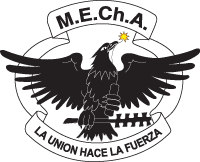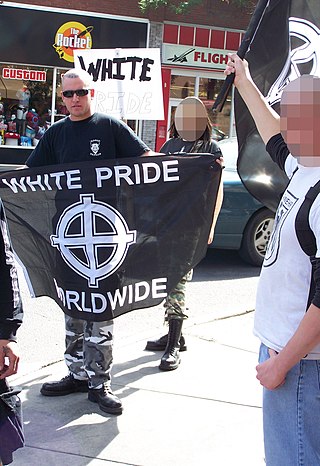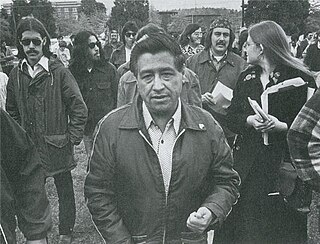
M.E.Ch.A. is a US-based organization that seeks to promote Chicano unity and empowerment through political action.

White pride and white power are expressions primarily used by white separatist, white nationalist, fascist, neo-Nazi, and white supremacist organizations in order to signal racist or racialist viewpoints. It is also a slogan used by the prominent post-Ku Klux Klan group Stormfront and a term used to make racist/racialist viewpoints more palatable to the general public who may associate historical abuses with the terms white nationalist, neo-Nazi, and white supremacist.

Proposition 209 is a California ballot proposition which, upon approval in November 1996, amended the state constitution to prohibit state governmental institutions from considering race, sex, or ethnicity, specifically in the areas of public employment, public contracting, and public education. Modeled on the Civil Rights Act of 1964, the California Civil Rights Initiative was authored by two California academics, Glynn Custred and Tom Wood. It was the first electoral test of affirmative action policies in North America. It passed with 55% in favor to 45% opposed, thereby banning affirmative action in the state's public sector.

Opposition to United States involvement in the Vietnam War began in 1965 with demonstrations against the escalating role of the United States in the war. Over the next several years, these demonstrations grew into a social movement which was incorporated into the broader counterculture of the 1960s.

The history of the University of Michigan began with its establishment on August 26, 1817 as the Catholepistemiad or University of Michigania.
The South African Students' Organisation (SASO) was a body of black South African university students who resisted apartheid through non-violent political action. The organisation was formed in 1969 under the leadership of Steve Biko and Barney Pityana and made vital contributions to the ideology and political leadership of the Black Consciousness Movement. It was banned by the South African government in October 1977, as part of the repressive state response to the Soweto uprising.

The Chicano Movement, also referred to as El Movimiento, was a social and political movement in the United States that worked to embrace a Chicano/a identity and worldview that combated structural racism, encouraged cultural revitalization, and achieved community empowerment by rejecting assimilation. Chicanos also expressed solidarity and defined their culture through the development of Chicano art during El Movimiento, and stood firm in preserving their religion.

The East Los Angeles Walkouts or Chicano Blowouts were a series of 1968 protests by Chicano students against unequal conditions in Los Angeles Unified School District high schools. The first walkout occurred on March 5, 1968. The students who organized and carried out the protests were primarily concerned with the quality of their education. This movement, which involved thousands of students in the Los Angeles area, was identified as "the first major mass protest against racism undertaken by Mexican-Americans in the history of the United States".
The Coalition to Defend Affirmative Action, Integration & Immigrant Rights, and Fight for Equality By Any Means Necessary, commonly shortened to By Any Means Necessary (BAMN), is a militant, American far-left group that participates in protests and litigation to achieve its aims. It is a front organization for the Revolutionary Workers League.

Campus protest or student protest is a form of student activism that takes the form of protest at university campuses. Such protests encompass a wide range of activities that indicate student dissatisfaction with a given political or academics issue and mobilization to communicate this dissatisfaction to the authorities and society in general and hopefully remedy the problem. Protest forms include but are not limited to: sit-ins, occupations of university offices or buildings, strikes etc. More extreme forms include suicide such as the case of Jan Palach's, and Jan Zajíc's protests against the end of the Prague Spring and Kostas Georgakis' protest against the Greek junta of 1967–1974.

Lotus Delta Coffman was the fifth president of the University of Minnesota, serving from 1920 until his death in office on September 22, 1938. Coffman Memorial Union, the main student center, is named in his memory.
The Black Student Movement (BSM) is an organization at the University of North Carolina at Chapel Hill. It is the second largest student-run organization and one of the largest cultural organizations on the school's campus. The organization was created on November 7, 1967, to combat problems of black recruit, admissions, and integration on UNC-CH campus.

Robben Wright Fleming, also known in his youth as Robben Wheeler Fleming, was an American lawyer, professor, and academic administrator. He was president of the University of Michigan from 1968 to 1979—and interim president again in 1988—and established a reputation for patience and willingness to engage in dialogue with students during the frequent campus protests of that era. He has been called "one of the truly great presidents of the University of Michigan" by former University president Mary Sue Coleman.
In 1968, the Third World Liberation Front (TWLF), a coalition of the Black Students Union, the Native Students Room, the Latin American Students Organization, the Filipino American Collegiate Endeavor (PACE) the Filipino-American Students Organization, the Asian American Political Alliance, and El Renacimiento, a Mexican-American student organization, formed at San Francisco State University (SFSU) to call for campus reform. Another Third World Liberation Front was formed at University of California, Berkeley in January 1969. These coalitions initiated and sustained the Third World Liberation Front strikes of 1968, one of the longest student strikes in US history.

In 2015, a series of protests at the University of Missouri related to race, workplace benefits, and leadership resulted in the resignations of the president of the University of Missouri System and the chancellor of the flagship Columbia campus. The moves came after a series of events that included a hunger strike by a student and a boycott by the football team. The movement was primarily led by a student group named Concerned Student 1950, referencing the first year black students were allowed to enroll in the university. The movement and protests were documented in two films, one made by MU student journalists and the other, 2 Fists Up, by Spike Lee. While it is alleged that bad publicity from the protests has led to dropping enrollment and cutbacks, others have cited budget cuts issued from the state legislature.
Affirmative action refers to activities or policies that seek to help groups that are often affected by discrimination obtain equal access to opportunities, particularly in areas such as employment and education. In the United States, in the early 2000s, the use of race, gender, and other factors in college and university admissions decisions came under attack.

The 2020 Michigan graduate students' strike was a labor strike launched by the Graduate Employees' Organization 3550, the graduate student employee union that represents approximately 2,100 graduate student instructors at the University of Michigan in Ann Arbor, Michigan, United States. The main cause of the strike was related to graduate students' objection to the university's plans for reopening during the COVID-19 pandemic. Additional calls were made by the union for defunding the campus police. The strike started on September 8, 2020, and was scheduled to last for four days, with a subsequent vote extending the strike for another week. Following the start of the strike, resident assistants and student employees for the university's dining services announced they would also strike over similar concerns regarding the university's COVID-19 policies.
In higher education in the United States, a Black Student Union (BSU) is an organization of Black students, generally with a focus on protest. Historically functioning as a Black counterpart to the largely white organization Students for a Democratic Society, Black Student Unions advocated for changes on college campuses during the Black Power movement. According to Ibram X. Kendi, the existence of the academic field of Black studies is a direct result of advocacy by Black Student Unions.
Marcellette ("Marci") Gaillard-Gay Williams is an American retired academic administrator who served as interim chancellor of the University of Massachusetts Amherst from July 2001 until July 2002. She was the university's eighth chancellor and the first woman to serve in the position.
#NotAgainSU is a hashtag and student led organization that began after several racist incidents occurred on the campus of Syracuse University, during the academic course of 2019-2021. Initial reports of racist paraphernalia occurred early November in the dorm buildings of first- and second-year undergraduate students. After nearly a month of daily reports, Syracuse students organized a sit-in where they occupied, and created an elaborate list of 19 demands for Chancellor Kent Syverud to sign. After several protests, some taking place at his persona residence, the list was signed with few revisions on November 21.











